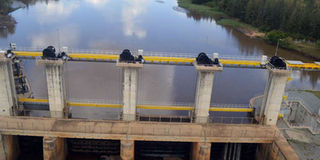Pending rainfall to save Kenyans from higher power bills

Sondu-Miriu hydroelectric power plant in Nyakach, Kisumu County, on February 14, 2018. The Sondu-Miriu project is currently operating at half capacity due to the declining water levels. PHOTO | ONDARI OGEGA | NATION MEDIA GROUP
What you need to know:
- Mr Keter said the government will complete construction of the geothermal line from Bomet to Narok in two weeks' time.
- Mr Keter also indicated that the adverse weather conditions have affected the Seven Forks power plant in Embu.
Kenyans could be forced to dig deeper into their pockets to pay for electricity bills if the current dry spell persists.
Energy Cabinet Secretary Charles Keter said that the decline in water levels is affecting the generation of hydroelectric power.
Mr Keter, who spoke after visiting the Sondu-Miriu hydroelectric power station in Kisumu County on Wednesday, said the government has been forced to resort to more expensive means of power generation to meet demand.
“We have been forced to use a diesel power plant in Muhoroni to reduce the power shortage being experienced in the western region,” he said.
WATER LEVELS
He said the government will complete construction of the geothermal line from Bomet to Narok in two weeks' time.
“Already, there is some work being done on the Olkaria-Narok line, while the Bomet line coming all the way to Chemosit has been done,” he said.
The CS added that the completion will help in the evacuation of geothermal power from Olkaria to help substitute hydroelectric power when there is a shortfall in rainfall.
He said it is disastrous for the country to rely on hydroelectric power by over 50 per cent.
The Sondu-Miriu project is currently operating at half capacity due to the declining water levels.
SEVEN FORKS
He said this had forced the management to wait until mid-day to start generating power after accumulating water from River Sondu.
Mr Keter also indicated that the adverse weather conditions have affected the Seven Forks power plant in Embu.
This comes a week after the CS indicated that the low water levels and prolonged drought could force the government to shutdown the power producing station, which relies on Masinga Dam.
Masinga power station produces 40 megawatts and is part of the crucial Seven Forks hydroelectricity system that Kenya relies on for cheap power.
RAINS
However, the CS said there is no cause for alarm as the March-May long rains, which are expected to start in the next two weeks, will boost the country’s hydroelectric power generation.
While the Meteorological Department is yet to publish the outlook for the March-May long rains season, the December outlook indicated that the forecast could range from below average to average in most parts of the country.





